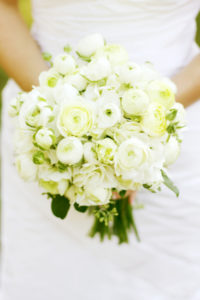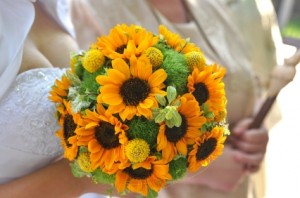A posy, tussie-mussie, nosegay, or more commonly known as a flower bouquet, is one of the most important bridal accessories on wedding day. Did you know that in its origins, the bridal bouquet served a surprising, functional, and very different purpose? Brides clutched aromatic arrangements of herbs and grains as they made their way down the aisle to ward of body odor and evil spirits! Luckily, modern brides face no such challenge.
Beautiful flowers have since replaced herbs, and the selections symbolize love and fertility. Popular wedding choices include the Rose, Carnation, Gardenia, Lily-of-the-Valley, Sweat Pea, Tulip, Orchid, Chrysanthemum, and Delphinium.
When Your Love is in Bloom, exercise your flower power when choosing floral arrangements for your wedding day. At a minimum, keep in mind that you will need flowers for the following purposes:
- Bride’s Bouquet
- Bridesmaids and Maid-of-Honor Bouquets
- Groom’s Boutonniere (button-hole/lapel flower)
- Groomsmen and Father-of-the-Bride Boutonnieres
- Mother-of-the-Bride Corsage (wrist or lapel flowers)
- Aisle Petals (typically sprinkled by the flower girl)
- Church/Ceremony Venue Decorations (typically placed on pews)
- Reception Venue Decorations
- Cake Flowers
Optional uses may include:
- Hairdressing Flowers for the bride, bridesmaids, maid-of-honor, or mother-of-the-bride.
- Corsages for other close female family members or friends.
- Boutonnieres (button-hole/lapel flower) for other close male family members of friends.
Nowadays, bouquets are chosen on the basis of personal preference, wedding themes, and color schemes. Although roses remain the number one choice, many brides opt for other floral varieties including orchids, tulips, or hyacinths. Bouquets are typically fashioned in several styles including the Teardrop, Cascade, Cluster Posy, Trailing Posy, and Arm Spray.
 The Teardrop bouquet has a trail that is wide and forms a teardrop shape at the bottom.
The Teardrop bouquet has a trail that is wide and forms a teardrop shape at the bottom.- The Cascade (or multiple trail) bouquet has numerous trails cascading from the top of the bouquet.
- The Posy bouquet will have smaller flowers that are bound tightly by their stems.
- The Arm Spray will be cradled in the forearm or may hang by the hand, with wider or loose trails that create a softer effect.
For a unique arrangement, many brides incorporate jewels or other decorative trinkets, seasonal flowers, natural elements (i.e. pine cones or seashells), silk flowers, or use flowers that represent their birth month:
- January – Carnation
- February – Iris
- March – Daffodil
- April – Daisy
- May – Lily-of-the-Valley
- June – Rose
- July – Larkspur
- August – Gladiolus
- September – Aster
- October – Marigold
- November – Chrysanthemum
- December – Narcissus
Whatever flower you choose, remember that your bouquet can be as unique as your imagination permits. Your floral stylist can assist you with your final choices.
Things to Remember:Â
- Do order your flowers in advance, but only after you have finalized your choices for color schemes.
- Consider the availability of flowers during the season that your wedding will take place.
- Consider the design and color of your wedding dress, as your bouquet should compliment your style and shape. Bridal portraits are typically taken in the weeks before the wedding, so your photographer may have additional suggestions for style and color.
When your wedding day arrives, remember that flowers may brown or wilt if left out too long or under the stress of extreme weather conditions. Consult your florist for further styling and preservation tips, and remember to inquire about delivery and set-up costs and alternatives for allergy considerations.
Happy Wedding Planning!





